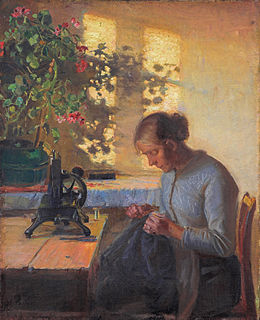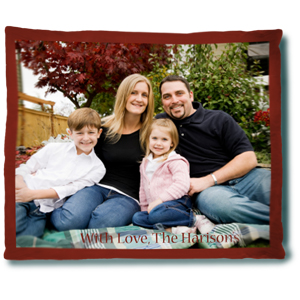
A textile is a flexible material made by creating an interlocking bundle of yarns or threads, which are produced by spinning raw fibers into long and twisted lengths. Textiles are then formed by weaving, knitting, crocheting, knotting, tatting, felting, bonding, or braiding these yarns together.
Yarn is a long continuous length of interlocked fibres, suitable for use in the production of textiles, sewing, crocheting, knitting, weaving, embroidery, or ropemaking. Thread is a type of yarn intended for sewing by hand or machine. Modern manufactured sewing threads may be finished with wax or other lubricants to withstand the stresses involved in sewing. Embroidery threads are yarns specifically designed for needlework.

Textile arts are arts and crafts that use plant, animal, or synthetic fibers to construct practical or decorative objects.

A rug is a piece of cloth, similar to a carpet, but it does not span the width of a room and is not attached to the floor. It is generally used as a floor covering, or as a decorative feature. Rug making is the process of crafting a rug from various textile materials. Historically, there has been a variety of methods of rug making, including braiding, hooking, and weaving. These processes can be carried out by hand, using smaller tools like a latch hook, or using a weaving machine. Rag rugs are a historically notable and widespread form of hooked rug making. Rug hooking is both an art and a craft where rugs are made by pulling loops of yarn or fabric through a stiff woven base such as burlap, linen, or rug warp. The loops are pulled through the backing material by using a crochet-type hook mounted in a handle for leverage.

Sewing is the craft of fastening or attaching objects using stitches made with a sewing needle and thread. Sewing is one of the oldest of the textile arts, arising in the Paleolithic era. Before the invention of spinning yarn or weaving fabric, archaeologists believe Stone Age people across Europe and Asia sewed fur and leather clothing using bone, antler or ivory sewing-needles and "thread" made of various animal body parts including sinew, catgut, and veins.

A braid is a complex structure or pattern formed by interlacing two or more strands of flexible material such as textile yarns, wire, or hair.

A carpet is a textile floor covering typically consisting of an upper layer of pile attached to a backing. The pile was traditionally made from wool, but since the 20th century, synthetic fibers such as polypropylene, nylon or polyester are often used, as these fibers are less expensive than wool. The pile usually consists of twisted tufts that are typically heat-treated to maintain their structure. The term carpet is often used in a similar context to the term rug, but rugs are typically considered to be smaller than a room and not attached to the floor.

A mat is a hard rug that generally is placed on a floor or other flat surface. Mats serve a range of purposes including:

A Persian carpet or Persian rug, also known as Iranian carpet, is a heavy textile made for a wide variety of utilitarian and symbolic purposes and produced in Iran, for home use, local sale, and export. Carpet weaving is an essential part of Persian culture and Iranian art. Within the group of Oriental rugs produced by the countries of the "rug belt", the Persian carpet stands out by the variety and elaborateness of its manifold designs.

A kilim is a flat tapestry-woven carpet or rug traditionally produced in countries of the former Persian Empire, including Iran, the Balkans and the Turkic countries. Kilims can be purely decorative or can function as prayer rugs. Modern kilims are popular floor coverings in Western households.

Metallic fibers are manufactured fibers composed of metal, metallic alloys, plastic-coated metal, metal-coated plastic, or a core completely covered by metal.
Linens are fabric household goods intended for daily use, such as bedding, tablecloths and towels. "Linens" may also refer to church linens, meaning the altar cloths used in church.

A spindle is a straight spike usually made from wood used for spinning, twisting fibers such as wool, flax, hemp, cotton into yarn. It is often weighted at either the bottom, middle, or top, commonly by a disc or spherical object called a whorl; many spindles, however, are weighted simply by thickening their shape towards the bottom, e.g. Orenburg and French spindles. The spindle may also have a hook, groove, or notch at the top to guide the yarn. Spindles come in many different sizes and weights depending on the thickness of the yarn one desires to spin.

Rug hooking is both an art and a craft where rugs are made by pulling loops of yarn or fabric through a stiff woven base such as burlap, linen, or rug warp. The loops are pulled through the backing material by using a crochet-type hook mounted in a handle for leverage. In contrast latch-hooking uses a hinged hook to form a knotted pile from short, pre-cut pieces of yarn.

A floorcloth, or floor-cloth, is a household furnishing used for warmth, decoration, or to protect expensive carpets. They were primarily produced and used from the early 18th to the early 20th century and were also referred to as oilcloth, wax cloths, and painted canvas. Some still use floorcloths as a customizable alternative to rugs, and some artists have elected to use floorcloths as a medium of expression. Most modern floorcloths are made of heavy, unstretched canvas with two or more coats of gesso. They are then painted and varnished to make them waterproof.

Tufting is a type of textile manufacturing in which a thread is inserted on a primary base. It is an ancient technique for making warm garments, especially mittens. After the knitting is done, short U-shaped loops of extra yarn are introduced through the fabric from the outside so that their ends point inwards.
The manufacture of textiles is one of the oldest of human technologies. To make textiles, the first requirement is a source of fiber from which a yarn can be made, primarily by spinning. The yarn is processed by knitting or weaving, which turns yarn into cloth. The machine used for weaving is the loom. For decoration, the process of colouring yarn or the finished material is dyeing. For more information of the various steps, see textile manufacturing.

A photo blanket is a large, rectangular piece of fabric displaying images, pictures, or designs, often with bound edges, used as a blanket or decorative object. Historically photo blanket were made of thick cloth depicting people, objects, and symbols intended to tell a story or reveal historical events.
Sewing is the craft of fastening or attaching objects using stitches made with needle and thread. Sewing is one of the oldest of the textile arts, arising in the Paleolithic Era. Although usually associated with clothing and household linens, sewing is used in a variety of crafts and industries, including shoemaking, upholstery, sailmaking, bookbinding and the manufacturing of some kinds of sporting goods. Sewing is the fundamental process underlying a variety of textile arts and crafts, including embroidery, tapestry, quilting, appliqué and patchwork.

String is a long flexible structure made from fibers twisted together into a single strand, or from multiple such strands which are in turn twisted together. String is used to tie, bind, or hang other objects. It is also used as a material to make things, such as textiles, and in arts and crafts. String is a simple tool, and its use by humans is known to have been developed tens of thousands of years ago. In Mesoamerica, for example, string was invented some 20,000 to 30,000 years ago, and was made by twisting plant fibers together. String may also be a component in other tools, and in devices as diverse as weapons, musical instruments, and toys.
















